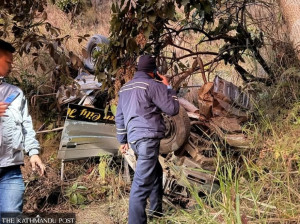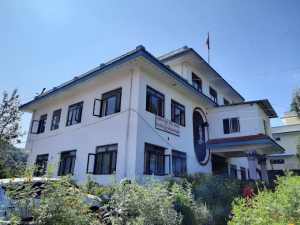Bagmati Province
Locals start drive to conserve endangered Asian woolly neck in Dhading
Number of Woolly Neck has decreased due to wetland degradation, reduction of nesting trees, use of pesticides and excessive hunting, conservationists say..jpg&w=900&height=601)
Harihar Singh Rathour
Residents of Gajuri Rural Municipality in Dhading have come together to protect Asian woolly neck stork, locally called Lovipapi Garud, after it was identified as an endangered bird species.
The rural municipality had called a team of conservationists, including ornithologists, from the Bird Conservation Nepal to identify the bird a few days ago. After the identity of the stork came into light, students of Kiranchok Secondary School in Gajuri Rural Municipality Ward No. 8 have started taking initiatives to protect the stork and its habitat.
“We know these birds as “Bhudiphor” here. They can be found roaming freely in our paddy fields,” said Bishwo Adhikari, a 12th grader at Kiranchok Secondary School. “Students would usually throw stones at them, not to kill them but to make them fly. But now we want to protect the endangered species. Many locals still don’t know about the stork, so we are working towards raising awareness among them.”
The Asian woolly neck (Ciconia episcopus) is in the IUCN Red List of Threatened Species 2017. The species is a large wetland-dependent bird of the stork group with its population distributed across South and South-East Asia.
The rural municipal office has also taken steps to preserve the bird species in coordination with students of Kiranchok Secondary School and Kiranchok Katunje Secondary School in Ward No. 9.
According to Rajendra Bikram Basnet, chairman of the rural municipality, the office is distributing posters and pamphlets in the communities to inform the locals about the species’ status and urging them to make efforts to conserve them. “We will mobilise students to disseminate information about conserving the stork and install some hoarding boards marking the birds’ habitat,” said Basnet.
Sabina Thapa Magar, a 12th grader at Kiranchok Secondary School, takes the stork’s presence in her village as a matter of pride.
“The endangered storks have made their home in our village, and that’s a good thing. We have commited to preserving this species,” she said.
Currently, only three to four pairs of the woolly neck are found in the rural municipality, but their population was up to 16 pairs until two years ago, said Khem Prasad Adhikari, a farmer in Rungata Bagaicha.
Conservationists said the number of the species has decreased due to wetland degradation, reduction of nesting trees, use of pesticides in farmlands and excessive hunting.
“After the earthquake, the rural municipality saw an influx of construction workers. They would hunt woolly neck for meat, and that’s one of the reasons why the stork’s population has declined,” Adhikari said.
Meanwhile, the rural municipal office, in its efforts to preserve the storks, plans to make these birds the identity of Gajuri.
“We have made public a plan to conserve endangered species including woolly neck and pangolin,” said Basnet.
Krishna Bhusal, an ornithologist, said the woolly neck is found in Kapilvastu, Rukum, Jajarkot, Rupandehi, Dhading, Pyuthan, Arghakhanchi, Chitwan among other districts of Nepal. The 2015 count found only 68 Asian woolly neck stork in 42 wetlands of the country.




 6.84°C Kathmandu
6.84°C Kathmandu-(2).jpg)












